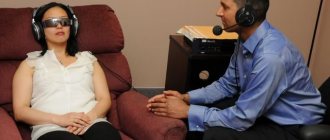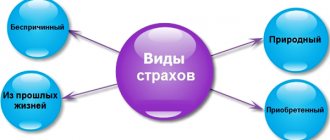Difference between neurosis and psychosis: comparison table
Without going into details, we note that neurosis differs from psychosis in virtually all respects: causes, onset and course of the disease, characteristic symptoms, the patient’s attitude to his condition and, of course, approach to treatment.
For clarity, the main differences are presented in the table:
| Clinical picture and principles of treatment | Neurosis | Psychosis |
| Onset of the disease. | Often occurs immediately after severe stress or trauma. | It begins almost asymptomatically. Determining the exact date of onset of the disease is very difficult. |
| Criticism of the disease. | The person realizes that he is sick and is ready to take measures to solve the problem. | The patient denies having problems and does not want to be treated. |
| Manifestations of the disease. | The characteristic symptoms of neurosis are usually somatoform: increased sweating, rapid heartbeat, fever, chills, or combinations thereof may be observed. | In psychosis, illusions and hallucinations of various types occur. |
| Personality change. | The patient's personality does not change. | The patient's personality undergoes significant changes. |
| Hospitalization. | Not required. The patient is not dangerous to others. | Mandatory requirement. The patient can harm both others and himself. |
| Specialists. | Psychotherapists treat neuroses. | Psychiatrists treat psychosis. |
For those who wish to delve into the issues of the difference between neuroses and psychoses in more detail, the following information will be useful.
Characteristics of neurosis
Neurosis is not a disease, but a painful condition that combines a whole group of psychogenic disorders and is traditionally considered as a functional disorder of the higher nervous activity of the upper nervous system.
Neurosis does not have an unambiguous definition either in biology or in medicine, but to one degree or another it is familiar to every person. In Russia alone, according to WHO, up to 75% of the population suffers from neurotic disorders, and every year the frightening figure is steadily growing.
Neuroses are dangerous. They can cause a lot of inconvenience, including complete loss of ability to work. But if you consult a specialist in a timely manner and follow the recommendations, they are completely curable. Neurologists and psychotherapists treat disorders of this kind.
The forms of neurosis are quite diverse. Conventionally, they can be divided into two large groups. The first group includes conditions associated with stress: various phobias in which anxiety is provoked by external situations and objects that are not currently dangerous. The second group includes conditions associated with physiological (physical) disorders: anorexia nervosa, bulimia, etc.
A term that combines a number of interdependent fears. For example, fear of leaving the apartment and entering the store. Fear of traveling and being in crowds.
The clinical picture of agoraphobia is very diverse. In most cases, symptoms such as dizziness, migraine, lightheadedness or rapid heartbeat are observed. The intensity of anxiety can vary from mild discomfort to panic terror.
40.Oharak. Psychopathy as a form of personality disharmony.
Psychopathy is a behavior disorder in children that is often congenital in nature.
Psychopathy arises based on the interaction of congenital or early acquired biological inferiority of the nervous system and the influence of the external environment. However, the influence of external factors for the formation of psychopathy is not enough. Psychopathy differs from a normal character, which is influenced by improper upbringing or pedagogical neglect, by the underlying inferiority of the nervous system. Deviations in behavior do not yet provide grounds to classify a person as a psychopathic individual. Psychopathy is not characterized by progression with the development of dementia and personality defects. It is also necessary to distinguish psychopathy from psychopath-like conditions after traumatic brain injury, infectious diseases, intoxication lesions of the central nervous system, endocrinopathies, etc. The main differential diagnostic criterion should be that before the appearance of psychopath-like changes in certain diseases, personality development was normal. In contrast to neuroses, in psychopathy, pathological character traits determine the entire mental appearance. Shapes:
Constitutional.
Children with this type of psychopathy have a hereditary predisposition to it. The level of mental development is not primarily affected. Different forms of psychopathy are formed: excitable, unstable, etc. With this etiology of psychopathy, external factors activate, “trigger” the existing predisposition.
Acquired.
It occurs under the influence of unfavorable factors of a psychological and social nature, such as improper upbringing, parental cruelty, and severe emotional shock. Under the influence of emotional stress that arises in conflict and crisis situations, exceeding in its intensity and duration the individual adaptive capabilities of the child, which manifests itself in emotional and behavioral disorders, difficulties in socialization, social interaction and learning.
Organic.
It develops as a result of the impact on the body of a child under three years of age of various unfavorable factors: severe toxicosis of pregnancy, birth injuries, etc.
1) Excitable.
Characterized by high excitability, combined with pronounced extroversion, suspicion, anger, stubbornness and pedantry. The behavior of children is characterized by cruelty, vindictiveness, extreme demands on others, and they enter into disputes on any occasion.
2) Unstable.
Children are characterized by increased emotional instability, unstable interests and attachments, and weakness of will. They have increased suggestibility, a tendency to fantasize, and impressionability.
3) Affective.
Children have different moods; they are always gloomy and sad. They are also uncommunicative, reserved and prone to lies.
4) Psychasthenic.
Children constantly experience a variety of fears, anxieties, and doubts about making decisions in connection with the responsibility entrusted to them. They tend to create various rituals in their behavior and are afraid of any changes.
5) Schizoid.
Children are characterized by pathological isolation, secrecy, and isolation from reality. weakness of emotional attachments up to callousness.
6)Hysterical.
Such children prefer to be visible and want to be the center of attention. Most often, girls have this type of psychopathy.
7) Parainoid
. The formation of extremely valuable ideas that are formed in them by the age of 30-25. Main character traits: stubbornness, straightforwardness, resentment, resentment, and self-confidence.
8) Asthenic.
Children are characterized by increased timidity, shyness, indecisiveness, and impressionability. Such children cannot stand the sight of blood.
9) Mosaic.
It is a combination of several forms of psychopathy.
Psychopathic personality
– an individual with persistent and clinically significant social deprivation of behavior or antisocial personality disorder.
Characteristics of psychosis
Psychosis is a serious mental illness that is often not cured, but only corrected by psychiatrists.
Depending on the chronological pattern, manifestations of psychosis are divided into episodic or periodic.
Psychoses characterized by movement disorders, affective disorders and pseudomanic states.
Movement disorders manifest themselves in the form of stupor. Patients freeze in unnatural positions, with wide-open eyes and an expression of suffering on their faces. Stupor may be replaced by increased motor or speech activity. Aggression towards others.
Affective disorders most often manifest as dysphoria. Patients are embittered, withdrawn, tearful, and prone to monotonous lamentations. Less common are fears, depression or euphoria, accompanied by illusory disorders or hallucinations.
Pseudomanic states manifested by senestopathies, rough monotonous pranks, hypochondriacal statements. Visual hallucinations, delusions of jealousy or persecution are possible.
The symptoms of psychosis are extremely broad. A wide variety of disorders may be present in mild or severe forms. Namely:
- Emotional disorders. Distortions of emotional reactivity (quantitative and qualitative changes in emotions), the sensory sphere (progress or regression of feelings) and mood (its decrease or increase). Patients experience higher feelings (personal dignity, aesthetic satisfaction) or, on the contrary, lower ones (arising from instincts or basic needs). They fall into depression and melancholy or experience euphoria and ecstasy. Sharp transitions from one state to another, emotional inadequacy, ambivalence, parapathy or parathymia are possible.
- Disorder of consciousness. Distortion of perception, memory and abstract thinking. Illusions and hallucinations. Patients cannot build logical connections between words, make unexpected conclusions, attach random meaning to certain concepts, and distort phrases without new semantic content. They cannot remember recent events, but they reproduce distant ones in their memory. They become disoriented in time, space and their own personality. Hallucinations are mainly visual: polyopic, hemianoptic, microscopic, autoscopic, Charles Bonnet type. Black and white or color. Extracampal, scene-like and others.
- Psychomotor disorders. Patients speak and move too slowly or too quickly. The transition from hypo to hyperactivity is unpredictable. The quadrigeminal reflex is strengthened.
- Sleep-wake rhythm disorders. Patients experience drowsiness during the day, but have difficulty falling asleep at night. They sleep restlessly and have nightmares at night, which after waking up can turn into hallucinations. In severe cases, inversion of the sleep-wake rhythm or total loss of sleep is possible.
The main differences between psychosis and neurosis
What is the difference between diseases is not understood by everyone. The main difference between neurosis and psychosis is that this mental disorder is reversible. The patient is aware of the presence of a problem, often independently turns to the doctor to receive professional help, the personality does not undergo changes.
The reasons for development also differ. Neuroses most often develop due to psychological trauma experienced in childhood and can appear after severe, prolonged stress; are formed in the absence of pronounced physical abnormalities, disorders, and pathologies. The appearance of psychosis is caused by dysfunction of the nervous and endocrine systems; The disease often develops slowly and is unnoticed in the initial stages.
In neurotic disorders, clinical manifestations of physical health are noted; psychotic disorders are characterized only by psychological symptoms.
Such a transition is impossible. The disorders have different etiologies. The severity of symptoms and the main symptoms also differ. Neurotic disorders are not initially a pathology: pathological processes can develop in the absence of help and treatment. Psychotic disorders are a disease from the very beginning and often develop spontaneously.
19) Depressive neurosis, neuropathic depression, dysthymia. Clinic, treatment.
D.N. is a psychogenically caused mild form of depression with a predominance of sad mood, adynamia, often with obsessions and hypochondrico-senestopathic phenomena. Situations leading to the development of DN: 1) “the patient’s entire life is unsuccessful” in all areas of activity; 2) forced to live in a situation of emotional deprivation. At the first stage, pronounced vegetative-somatic conditions are noted. Characteristic: fluctuations in blood pressure, palpitations, dizziness, etc. Afterwards, a decrease in mood, sleep disturbances develop, it is often difficult to fall asleep, it is more painful to wake up in the middle of the night, when the feeling of anxiety and palpitations intensify. Typical is hope for a “bright future” (patients do not have a sad assessment of the future, they are not bothered by the thought of the futility of the situation and condition). Dysthymia is a “mood disorder” that includes almost exclusively endogenous mood disorders. Treatment: a complex of therapeutic measures includes general strengthening treatment (vitamins, nootropics, diet, walks, physical exercises, etc.), medication therapy and, of course, psychotherapy. The complex of medications includes antidepressants with a stimulating effect, and for anxiety - small doses of antipsychotics.
studfiles.net
Symptoms of psychoses and neuroses
In psychosis, the characteristic symptoms are visual and auditory hallucinations. A person often has delusional, obsessive ideas. There may be a lack of understanding of reality. The patient is not capable of adequate perception of the surrounding world. Mood changes frequently, uncontrolled aggression is possible, which can turn into physical violence. People with this pathology are easily irritated; Even a minor reason can cause anger; sometimes anger arises for no reason. Speech is abrupt and chaotic. Characteristic is a gradual development of symptoms.
Neuroses have other manifestations. The nervous system is exhausted, there is a constant feeling of fatigue, apathy, and reluctance to do anything. A person gets tired quickly, suffers from headaches, and has difficulty falling asleep. Hysteria is possible: emotional reactions become excessively violent, chaotic movements and speech disturbances are observed during a seizure. Perhaps restlessness, constant causeless anxiety. Patients are suspicious, prone to obsessive actions and thoughts.
Often only some of the symptoms appear.
50) Obsessive-compulsive neurosis. Clinic and diagnostics. Position in ICD-io. Treatment.
Obsessive-compulsive neurosis is the general name for neuroses, manifested by obsessive fears, ideas, memories, doubts, etc. The disease usually begins with obsessive fear - phobia, then obsessive compulsive disorders (such as contrasting drives) and later other obsessive states such as obsessive disorders appear.
At the beginning of the disease, phobias arise through the mechanism of a conditioned reflex in identical situations, then the conditions for the emergence of fear expand. Three stages of development of the phobic stage of obsessive-compulsive neurosis: stage 1, the emergence of fear when directly confronted with a traumatic situation (for example, a trip on the subway, where the fear arose), in stage 2, the emergence of a phobia while waiting for a meeting with a traumatic situation (for example, while waiting for a trip to the subway ), for stage 3, the emergence of fear arises with just the idea of the possibility of this situation. Expansion of situations causing fear is typical. Obsessive fears are usually accompanied by various protective actions - rituals. NNS in ICD-10 seems to break down into smaller private forms, which can be represented as successive stages - variants of the development of this disease. NNS: anxiety-depressive disorders; phobic disorders6 agrophobia, social phobia, etc.; obsessive-communication disorders; obsessive states; contrast obsession; taking possession. Treatment: a complex of therapeutic measures includes general strengthening treatment (vitamins, nootropics, diet, walks, physical exercises, etc.), medication therapy and necessarily psychotherapy (auto-training). For obsessive-compulsive disorder, a combination of antidepressants (aminotriptyline) with antipsychotics (haloperidol)







